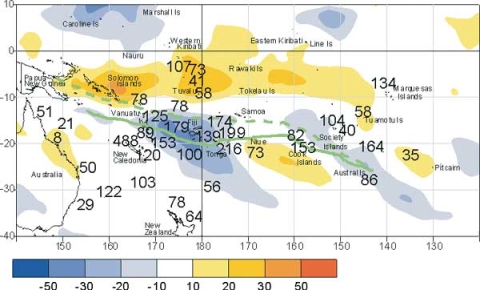Climate developments in April 2002
Active convection over Fiji and Tonga
High rainfall in parts of New Caledonia
Low rainfall from the Solomon Islands across to the northern Cook Islands
The SPCZ was displaced further south than average about and west of the date line, with a large area of enhanced convection affecting Fiji and Tonga, with another convective band further east extending from the Southern Cook Islands to the south of French Polynesia. Other regions of enhanced convection associated with the Inter-tropical Convergence Zone (ITCZ) affected regions north of the equator, including the Caroline and Marshall Islands and parts of eastern Kiribati. Rainfall was at least 125% of average at many locations within these convective regions. Rainfall was also at least 125% of average in northern areas of New Caledonia, due to high rainfall at the start of the month.
A very extensive region of divergence, with sunny conditions, extended from the Solomon Islands across to the east of the Northern Cook Islands, affecting most islands between 5 and 10°S, with less than 75% of average rainfall in many areas. Low rainfall (less than 50% of average) rainfall continued on the Queensland coast of Australia, extending into the western Coral Sea. Willis Island having now recorded nine consecutive months with less than 75% of average rainfall.
High mean April air temperatures (1.0°C or more above average), associated with unusually warm sea surface temperatures, were measured in Fiji and central French Polynesia.
High April rainfall was recorded at:
| Country | Location | Rainfall (mm) | % of normal | Comments |
|---|---|---|---|---|
|
New Caledonia |
Koumac |
341 |
488 |
Highest |
|
New Caledonia |
Moue |
314 |
243 |
Extremely high |
|
Tonga |
Fua’amotu Airport |
327 |
216 |
2nd highest |
Unusually high mean April air temperatures were recorded at:
| Country | Location | Mean air temperature °C | Departure from average | Comments |
|---|---|---|---|---|
|
Fiji |
Rotuma |
28.6 |
+1.5 |
Extremely high |
|
Fiji |
Nabouwalu |
27.7 |
+1.6 |
Extremely high |
|
Fiji |
Laucala Bay |
27.6 |
+1.9 |
Extremely high |
|
French Polynesia |
Tahiti-Faaa |
28.3 |
+1.2 |
Highest |
|
French Polynesia |
Tuamotu, Takaroa |
29.3 |
+1.0 |
Extremely high |

